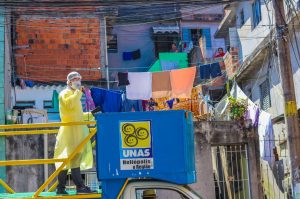As I am writing this article, someone is being infected by the novel coronavirus (Sars-CoV-2) around the world and the statistics of the pandemic are updated and disseminated by some online platforms, such as the Coronavirus COVID-19 Global Cases, created by the Center for Systems Science and Engineering (CSSE) at Johns Hopkins University.
And in certain parts of the globe, countless families are concerned about the virus and how to get access to food, clean water and health care. Even though their addresses, faces, ethnicities and social and economic conditions are familiar to the media, world leaders and the UN system, their suffering has fallen into an embarrassing silence and invisibility.
Since the World Health Organization (WHO) declared the novel coronavirus outbreak a pandemic, on March 11, some political and business leaders have tried to convince the public opinion that “we are in the same boat”.
Even if the risks of COVID-19 are widely spread around the planet, among rich and poor nations, like a cartography of the “risk society”, in the Ulrich Beck meaning, the world has seen the consequences and the costs of having not done anything to reduce the historic level of inequalities that exists today.
As in every disaster, nothing is sudden but the result of a social construction accepted over time, including its impacts in disparate realities. If COVID-19 is new to the worldwide societies, the social inequality – which is responsible for leaving the worst marks of the coronavirus across the world – is an old-know. As well as we learned to recognize the geopolitics of climate change, especially from the perspective of Antony Giddens, we must do the same with COVID-19.
In my country, Brazil, while some women have to focus on minimizing the health and economic impacts of COVID-19 on themselves and families, other women are struggling to provide dignity for their children – at least food. It is their prime struggle. Therefore, we are not facing a public health emergency, not in a strict sense, as the politicians and parts of the media want to demonstrate with their narratives, but we are seeing the other faces of a pandemic, its social, cultural, political, economic, ethical and moral features.
If you ask ordinary people from whom they would expect this understanding of the multifaceted nature of a pandemic, they could answer the UN system, governments and mainstream media.
The understanding, however, came from those who historically have suffered the burden of social inequality. Without voice and strength, the most vulnerable people – or people in the most vulnerable situations euphemistically speaking –had only one chance to draw attention to their reality: the community leaders. Faced with standardized messages and statements from WHO and the local governments, the community leaders have promoted risk communication campaigns addressed to the realities of the poor communities.
Consider Brazil as an example. Half of its citizens, around 105 million, don’t have access to sanitation systems and according to data from the Brazilian Institute of Geography and Statistics (IBGE), in 2018, 52.5 million were living in poverty and 13.5 million in extreme poverty [US$ 36 a month]. In this context we must reflect on two points: Why the communication campaigns are standardized in a world with social disparities? What is the role of the social institutions historically created to protect the most vulnerable groups?
During a humanitarian crisis and emergencies, the social institutions must be strong, and to be seen to be strong. In the context of a humanitarian crisis, like that arising from the coronavirus outbreak, it is crucial to build the perception that the most vulnerable groups are not alone.
The communication campaigns, declarations or protocols of WHO are non-binding, therefore, their success depends on the efforts and response capacities of each UN member state and the understanding of the local social framework. Even so, in its declarations WHO has forgotten to highlight this understanding and to address messages to the vulnerable groups or to their true leaders, showing awareness on the geopolitics of COVID-19.

Healthcare agent speaks to Heliopolis’ residents about Covid-19. Photo by UNAS Communication | Douglas Cavalcante
Since the beginning of risk communication studies as a field of public health, around the 1980s, we have learned to recognize the potential of communication to build resilience, to promote horizontal decision-making practices and to give ways to social institutions to build their credibility vis-à-vis the communities. In the context of a pandemic, people need to trust in someone to show they are not alone facing the uncertain scenarios in short or long term.
While I am finishing this text, a community leader is providing dignity to the members of her or his community, including food and information adapted to their social reality.
The metaphor of the oxygen mask must be used for community leaders around the world. They are showing to the rest of the world how to understand the meaning of Sustainable Development Goal 16 of the 2030 Agenda: Peace, Justice and Strong Institutions.



